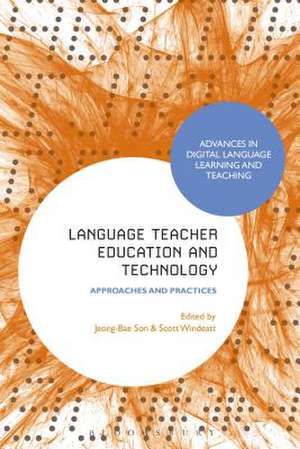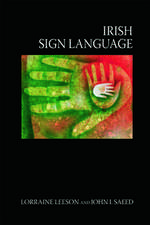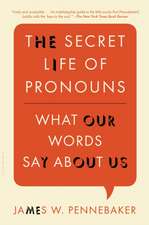Language Teacher Education and Technology: Approaches and Practices: Advances in Digital Language Learning and Teaching
Editat de Dr Jeong-Bae Son, Dr Scott Windeatten Limba Engleză Paperback – 26 dec 2018
| Toate formatele și edițiile | Preț | Express |
|---|---|---|
| Paperback (1) | 228.35 lei 6-8 săpt. | |
| Bloomsbury Publishing – 26 dec 2018 | 228.35 lei 6-8 săpt. | |
| Hardback (1) | 826.25 lei 6-8 săpt. | |
| Bloomsbury Publishing – 28 iun 2017 | 826.25 lei 6-8 săpt. |
Din seria Advances in Digital Language Learning and Teaching
- 23%
 Preț: 192.51 lei
Preț: 192.51 lei - 13%
 Preț: 256.08 lei
Preț: 256.08 lei - 13%
 Preț: 237.74 lei
Preț: 237.74 lei - 22%
 Preț: 237.64 lei
Preț: 237.64 lei - 23%
 Preț: 229.36 lei
Preț: 229.36 lei - 22%
 Preț: 258.56 lei
Preț: 258.56 lei - 23%
 Preț: 228.82 lei
Preț: 228.82 lei - 13%
 Preț: 256.00 lei
Preț: 256.00 lei - 23%
 Preț: 198.22 lei
Preț: 198.22 lei - 23%
 Preț: 191.27 lei
Preț: 191.27 lei - 31%
 Preț: 567.16 lei
Preț: 567.16 lei - 31%
 Preț: 566.66 lei
Preț: 566.66 lei - 31%
 Preț: 564.95 lei
Preț: 564.95 lei -
 Preț: 327.06 lei
Preț: 327.06 lei -
 Preț: 330.42 lei
Preț: 330.42 lei
Preț: 228.35 lei
Preț vechi: 296.50 lei
-23% Nou
Puncte Express: 343
Preț estimativ în valută:
43.70€ • 45.96$ • 36.51£
43.70€ • 45.96$ • 36.51£
Carte tipărită la comandă
Livrare economică 09-23 ianuarie 25
Preluare comenzi: 021 569.72.76
Specificații
ISBN-13: 9781350094710
ISBN-10: 1350094714
Pagini: 336
Dimensiuni: 156 x 234 x 18 mm
Greutate: 0.29 kg
Editura: Bloomsbury Publishing
Colecția Bloomsbury Academic
Seria Advances in Digital Language Learning and Teaching
Locul publicării:London, United Kingdom
ISBN-10: 1350094714
Pagini: 336
Dimensiuni: 156 x 234 x 18 mm
Greutate: 0.29 kg
Editura: Bloomsbury Publishing
Colecția Bloomsbury Academic
Seria Advances in Digital Language Learning and Teaching
Locul publicării:London, United Kingdom
Caracteristici
Covers the use of technology adopted in areas of Australia, the UK and the US and best practice approaches to training teachers worldwide
Notă biografică
Jeong-Bae Son, PhD, is Associate Professor in Applied Linguistics and TESOL in the School of Linguistics, Adult and Specialist Education at the University of South Queensland, Australia.Scott Windeatt is Senior Lecturer in Applied Linguistics and TESOL in the School of Education, Communication and Language Sciences at Newcastle University, UK.
Cuprins
List of Tables and FiguresNotes on ContributorsPreface1. Teacher Training in Computer-Assisted Language Learning: Voices of Teacher Educators, Jeong-Bae Son and Scott Windeatt 2. Language and Technology: Theory and Practice, Options and Issues in Computer-Assisted Language Learning, Mike Levy and Paul J. Moore3. Blended Approaches to Teaching Languages with Computers, Paul Gruba4. CALL Research, Practice and Teachers' Roles, Jeong-Bae Son5. Language Learning and Technology: A Thirty Year Journey, Gary Motteram6. Balancing Theory and Practice: Developing Competent, Reflective CALL Practitioners, Eddy Moran 7. Training Teachers to Create and Use Materials for Computer-Assisted Language Learning, Scott Windeatt8. Preparing CALL Professionals: A Survey Course in a CALL Degree Program, Greg Kessler9. Teacher Training with CALL Online (Distance): A Project- and Standards-Based Approach, Christine Bauer-Ramazani10. An Invitation to CALL: Foundations of Computer-Assisted Language Learning, Philip Hubbard11. Should we offer a CALL course?, Denise E. Murray Index
Recenzii
This volume contributes to the discussion of CALL teacher education by providing valuable insight into how CALL professionals and educators have structured their teacher training courses and addressing the challenges that they have encountered while doing so. Taken together, the variety of contributions to the volume and breadth that is covered across each of the courses outlined offers readers a valuable resource and can promote common knowledge of how to deal with current changes and challenges.
This is a very resourceful book, providing various angles to those who are to reflect upon an existing English Language course integrated with technology or those who will develop one ... [It] offers information that is not only relevant to the western regions mentioned but also transferrable elsewhere.
The topic, how to best teach and learn about using computers to aid language learning, is very important in today's world, especially in relation to current communicative language learning pedagogy. A pertinent question to be asked by any educator is how to best use computers to support language learning. This book gives some answers to this question, but its scope is more to give guidance on how to best set up training in the use of computers for language teachers. Advice found in the book can help to give a suitable platform for language teachers and this is, of course, pertinent as they operate at the interface between teaching and learning...I recommend the book to any educator, manager, technology designer or practitioner who wants to create a course in support of CALL at their educational establishment.
In an ideal world, CALL would be invisible or at least normalized. CALL courses would be irrelevant. Since we are not living in such a world, this book comes as a welcome eye-opener for teacher educators. It shows an inspiring range of possibilities, in a delicate balance between theory versus practice, technological versus non-technological activities, using versus creating materials, formative versus summative assessment, hardware versus software requirements, and teacher versus student initiative.
Put together with an eye to clarity and exhaustiveness, this collection provides an overview and analysis of nine (mainly) postgraduate CALL training courses for language teachers. What is unique about it is its commitment to the individual voices and authentic experiences of its contributors, all of whom were or are in charge of such programmes, and its attention to CALL language teacher training as a proper field, with a history and a future evolution of its own. This book is a precious tool for those teaching language teachers to teach with CALL.
This is a very resourceful book, providing various angles to those who are to reflect upon an existing English Language course integrated with technology or those who will develop one ... [It] offers information that is not only relevant to the western regions mentioned but also transferrable elsewhere.
The topic, how to best teach and learn about using computers to aid language learning, is very important in today's world, especially in relation to current communicative language learning pedagogy. A pertinent question to be asked by any educator is how to best use computers to support language learning. This book gives some answers to this question, but its scope is more to give guidance on how to best set up training in the use of computers for language teachers. Advice found in the book can help to give a suitable platform for language teachers and this is, of course, pertinent as they operate at the interface between teaching and learning...I recommend the book to any educator, manager, technology designer or practitioner who wants to create a course in support of CALL at their educational establishment.
In an ideal world, CALL would be invisible or at least normalized. CALL courses would be irrelevant. Since we are not living in such a world, this book comes as a welcome eye-opener for teacher educators. It shows an inspiring range of possibilities, in a delicate balance between theory versus practice, technological versus non-technological activities, using versus creating materials, formative versus summative assessment, hardware versus software requirements, and teacher versus student initiative.
Put together with an eye to clarity and exhaustiveness, this collection provides an overview and analysis of nine (mainly) postgraduate CALL training courses for language teachers. What is unique about it is its commitment to the individual voices and authentic experiences of its contributors, all of whom were or are in charge of such programmes, and its attention to CALL language teacher training as a proper field, with a history and a future evolution of its own. This book is a precious tool for those teaching language teachers to teach with CALL.










